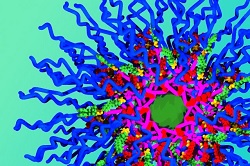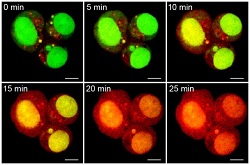 |
| Nanoparticle made of building blocks capable of carrying three drugs, and potentially more, holds doxorubicin (red), camptothecin (small green) and cisplatin (large green core).--Courtesy of MIT |
At MIT, researchers have developed nanoparticles that can carry as many as three cancer drugs at a time in a precise ratio.
In the past, nanoparticles have been able to carry up to two chemotherapy treatments at a time, but the MIT team has loaded theirs with three ovarian cancer drugs, offering a unique treatment regimen to kill more cancer cells with fewer side effects, according to a university report.
The team published the study in the Journal of the American Cancer Society demonstrating that, in animal tests, these "triple-threat" nanoparticles killed more of the ovarian cancer cells than particles carrying one or two drugs did. The scientists used the cancer drugs cisplatin, doxorubicin and camptothecin, each according to their maximum tolerated dose.
 |
| Nanoparticles release doxorubicin over time when exposed to ultraviolet light.--Courtesy of MIT |
Many drug-carrying vehicles are made before loading the treatment, allowing for only one drug inside the particle and one on the surface, limiting the potential to carry more than that, according to the report. But the MIT scientists created particle building blocks that included the drugs themselves and that could be built together into a single delivery vehicle. Each drug can then be released in response to a separate triggering mechanism.
"This is a new way to build the particles from the beginning," lead author Jeremiah Johnson said in a statement. "If I want a particle with 5 drugs, I just take the 5 building blocks I want and have those assemble into a particle. In principle, there's no limitation on how many drugs you can add, and the ratio of drugs carried by the particles just depends on how they are mixed together in the beginning."
Moving right along with this strategy, Johnson and his team are now working on particles that carry four drugs.
- here's the MIT report
- get the research abstract